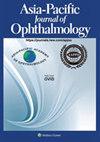Advances in understanding and management of IgG4-related ophthalmic disease
IF 4.5
3区 医学
Q1 OPHTHALMOLOGY
引用次数: 0
Abstract
Immunoglobulin G4-related ophthalmic disease (IgG4-ROD) is an emerging, immune-mediated fibroinflammatory orbital disease, characterized by tumefactive lesions with noticeable IgG4+ plasma cell infiltration and distinctive pathohistological features. This disease is often associated with elevated serum IgG4 concentrations. IgG4-ROD may affect any ophthalmic tissues, particularly the lacrimal gland, extraocular muscles, and trigeminal nerves. Although the exact pathogenic role of IgG4 antibodies remains unclear, B-cell depleting agents have been reported to be an effective treatment. The diverse clinical manifestations of IgG4-ROD complicate diagnosis, and without prompt treatment, visual-threatening complications such as optic neuropathy may arise. Recent advances in understanding and managing IgG4-ROD have revolutionized the diagnosis and treatment of this emerging disease. This review article aims to provide a comprehensive overview of the latest advancements in the field of IgG4-ROD.
对 IgG4 相关眼科疾病的认识和管理进展。
免疫球蛋白 G4 相关眼科疾病(IgG4-ROD)是一种新出现的免疫介导的眼眶纤维炎性疾病,其特征是具有明显 IgG4+ 浆细胞浸润的肿瘤活性病变和独特的病理组织学特征。这种疾病通常与血清 IgG4 浓度升高有关。IgG4-ROD 可影响任何眼科组织,尤其是泪腺、眼外肌和三叉神经。尽管 IgG4 抗体的确切致病作用尚不清楚,但有报道称 B 细胞去势药物是一种有效的治疗方法。IgG4-ROD 的临床表现多种多样,使诊断变得复杂,如果不及时治疗,可能会出现视神经病变等威胁视力的并发症。近年来,对 IgG4-ROD 的认识和管理取得了进展,为这一新兴疾病的诊断和治疗带来了革命性的变化。这篇综述文章旨在全面概述 IgG4-ROD 领域的最新进展。
本文章由计算机程序翻译,如有差异,请以英文原文为准。
求助全文
约1分钟内获得全文
求助全文
来源期刊

Asia-Pacific Journal of Ophthalmology
OPHTHALMOLOGY-
CiteScore
8.10
自引率
18.20%
发文量
197
审稿时长
6 weeks
期刊介绍:
The Asia-Pacific Journal of Ophthalmology, a bimonthly, peer-reviewed online scientific publication, is an official publication of the Asia-Pacific Academy of Ophthalmology (APAO), a supranational organization which is committed to research, training, learning, publication and knowledge and skill transfers in ophthalmology and visual sciences. The Asia-Pacific Journal of Ophthalmology welcomes review articles on currently hot topics, original, previously unpublished manuscripts describing clinical investigations, clinical observations and clinically relevant laboratory investigations, as well as .perspectives containing personal viewpoints on topics with broad interests. Editorials are published by invitation only. Case reports are generally not considered. The Asia-Pacific Journal of Ophthalmology covers 16 subspecialties and is freely circulated among individual members of the APAO’s member societies, which amounts to a potential readership of over 50,000.
 求助内容:
求助内容: 应助结果提醒方式:
应助结果提醒方式:


